
note
Ryan McIlraith on editing for rapid VFX at SNL
Ryan McIlraith of the SNL digital shorts team on producing a VFX edit during the already chaotic and exciting process of getting a short to air within rapid constraints.
My name is Ryan McIlraith, wonderful to meet you all! I am a director and editor along with my brother Sean. Sean and I have been working together since we were 12 years old and you can take a look at our website below! I am currently a film unit editor at Saturday Night Live along with my brother Sean and Ryan Spears. Every week, each one of us edits our own short in a 30 hour timeline. It is both terrifying and a delight.
https://mcilraithbrothers.com/
Chucky was a blast to work on, but was one of the more insane ones that I’ve ever been a part of at the show. This was written by Dan Bulla (who I’ve collaborated with many times) and Sarah Sherman (who I’ve never collaborated with). Due to the heavy nature of the visual (VFX), Mike Diva directed it as he has done many VFX pieces and is rather comfortable doing them.
The shoot began on a Friday at 11am at a studio located about a mile away from 30 Rock. Nick Vaiano, an incredible Post PA we have at the show, was on set media managing. Every hour we had him asking the assistant camera operator’s to break cards so we could receive the footage as fast as possible. On a typical show, we’d wait until the end of a shoot day to load in all the footage, but at SNL, time is not on our side. With less than 30 hours to edit a piece, we need to ensure that we are assembling footage throughout the day. On such a heavy visual effects piece, I need to assemble stuff immediately to make sure we are getting all of the pieces we need to make the edit work.
Once the cards are uploaded to the SAN at 30 rock, Paul Del Gesso, who works with me as the assist (and is a great editor in his own right) will begin multi-clipping and breaking out all of the clips in string outs. This was a big piece so we had two additional assistant editors on it, Kristie Ferriso and Bianca Ramdarsingh. Around 3:30pm on Friday, I was first given a bunch of footage from the bathroom to start editing, but it was just the coverage of Ego, Chloe & Melissa. I began to just simply pull takes that I thought may play well off of Sarah’s performance as Chucky, though I hadn’t seen any of Sarah’s Chucky footage yet. However, Sarah was reading lines off camera as Chucky, so I started using that as a guide for how the scene should be paced out. I began cutting everything around the Chucky performances and just leaving black video along with the off-camera audio for Sarah’s takes. Due to the nature of how complex the VFX were, I knew we would need to lock it super early on Saturday to give the visual effects team a fighting chance at getting all of the Chucky shots done for Dress Rehearsal. Around 8pm on Friday, I started getting footage of the puppeteer operating Chucky. This is when my initial panic set in. Seeing the people dressed in green suits, operating the doll, made me a bit anxious about the VFX workflow. Though these are the same people that pulled off the VFX for “Tiny Horse,” I knew, somehow, they’d be able to do it.
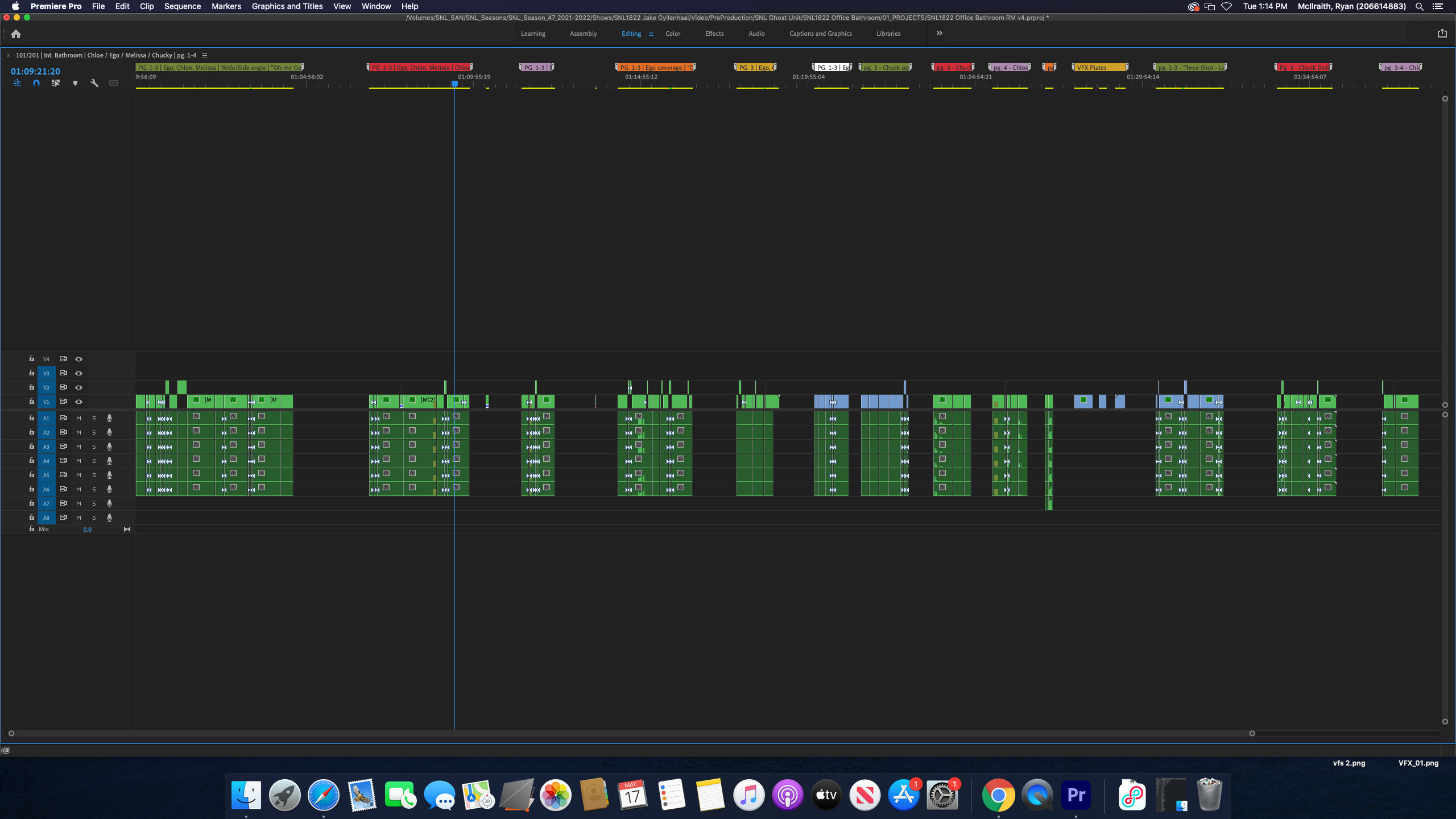
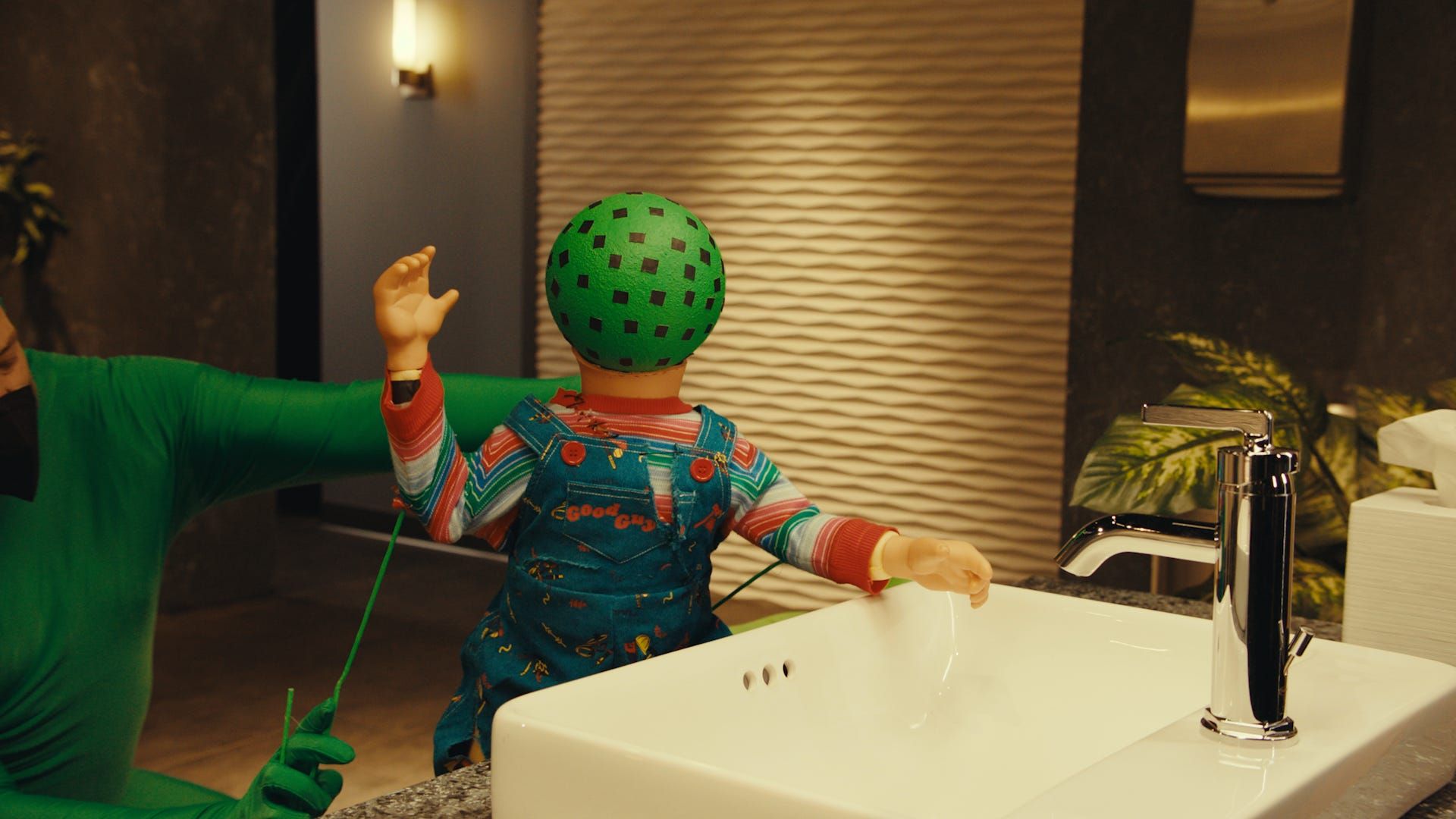
Around 10pm, I began to receive Sarah’s performance as Chucky, where she was shot entirely against a green screen. I had Kristie and Bianca do a line by line string out of all of Sarah’s performances so on Saturday there was no trouble immediately swapping a line read or take if we had to. Paul Del Gesso and I began sifting through all of her takes and picking ones that we thought worked the best. We used a simple Ultra Key along with an opacity mask to paste her head on top of the doll’s body. For shots where the doll was moving, or walking, we’d do a simple track to the head just so that if the writers came in at any point, we could at least attempt to sell the gag. I am a firm believer that nothing should feel like a rough cut when you watch it. So I tend to work meticulously on sound design before I cut anything. I will build sound beds and pick specific sound effects that correspond to the script prior to editing any picture. There is a big moment in this piece at the end of the bathroom scene where Chucky pulls out a knife and chases Chloe down with it. I knew that this had to play like horror and that it was going to be a big VFX moment. I built a ton of sound design and then began dropping the shots in. If I could sell this moment to the writers and producers, without any of the final VFX in, I knew I could put their mind’s at ease.
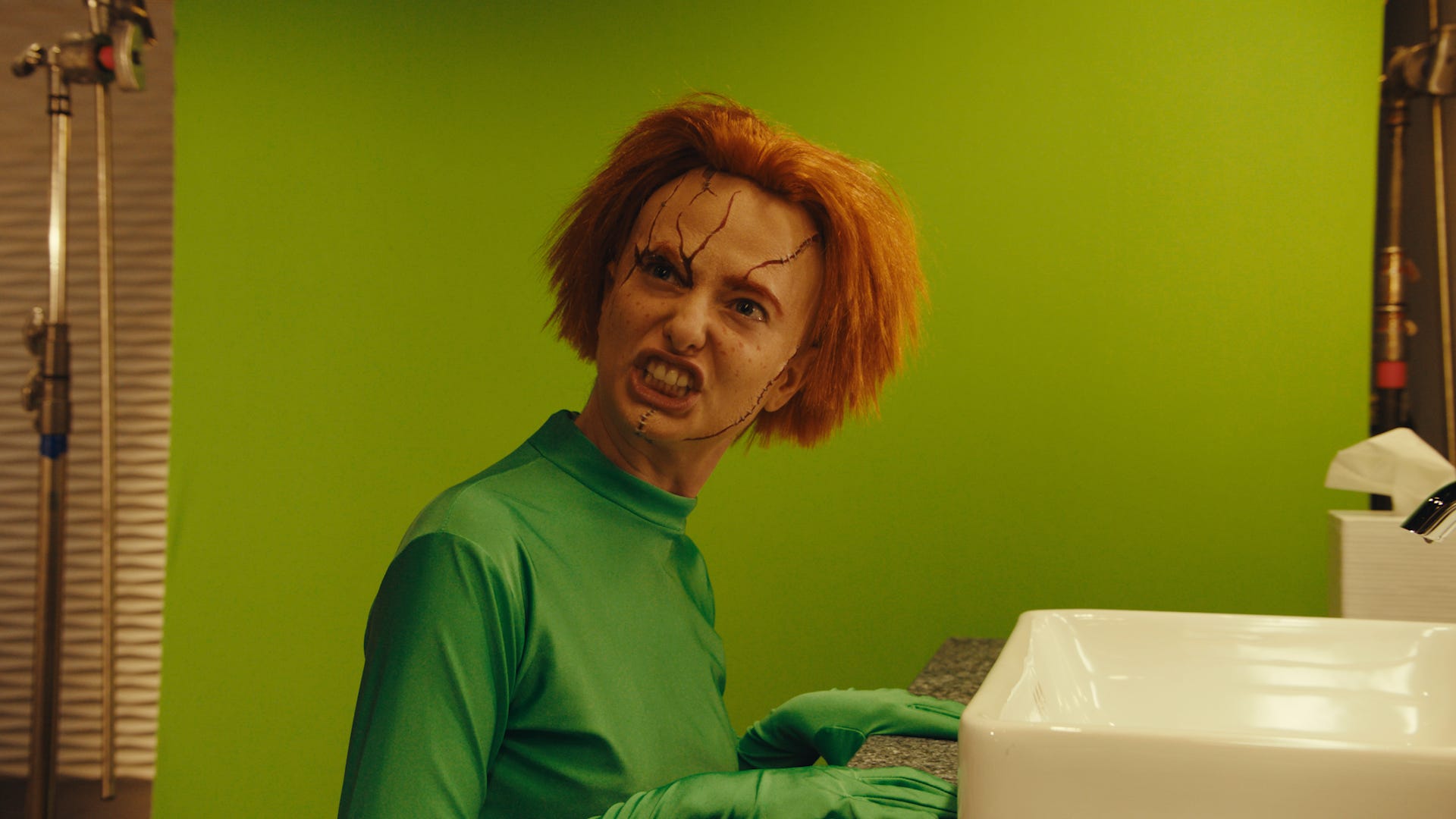
They wrapped the shoot around 12:30am Saturday morning. I stayed until 5:30am assembling the cut as I knew we had to have a rock solid edit to kick off Saturday.
Around 11am, I was back at 30 Rock. The visual effects team (Milton Ladd, Richard Lampson, Hugo Marmugi, Sohee Sohn, Jason Dorris, Mack Williams, Aaron Nelson-Purcell, Danny Behar) had already begun lightly working on the VFX shots just to wrap their minds around it. We gave the writers a drop dead of 2:00pm for all of the VFX shots. Sarah came up to work with me around 12:30pm to pick all of her performance takes. A lot of the takes I chose stayed, though we ended up swapping quite a few of her performance takes. Any takes that she signed off on, Paul Del Gesso would grab them and stick them in a timeline to export for the visual effects team. Due the the rapid pace and ever changing nature of an SNL piece, Paul had to do this on a rolling basis. Once the shot was locked, he’d immediately grab it and send. In my timeline, I label every VFX shot teal. This is an easy way for the assistant editor to open up my sequence and immediately see what needs to be sent to the visual effects team. I am lucky in that Paul works at a desk right along side mine so he is privy to all of the conversations with the writers, producers and director. This way he doesn’t have to constantly check in with me to find out if a shot is locked, he can figure that out just by listening or turning in his chair to check with everybody and confirm. That saves us an immeasurable amount of time.
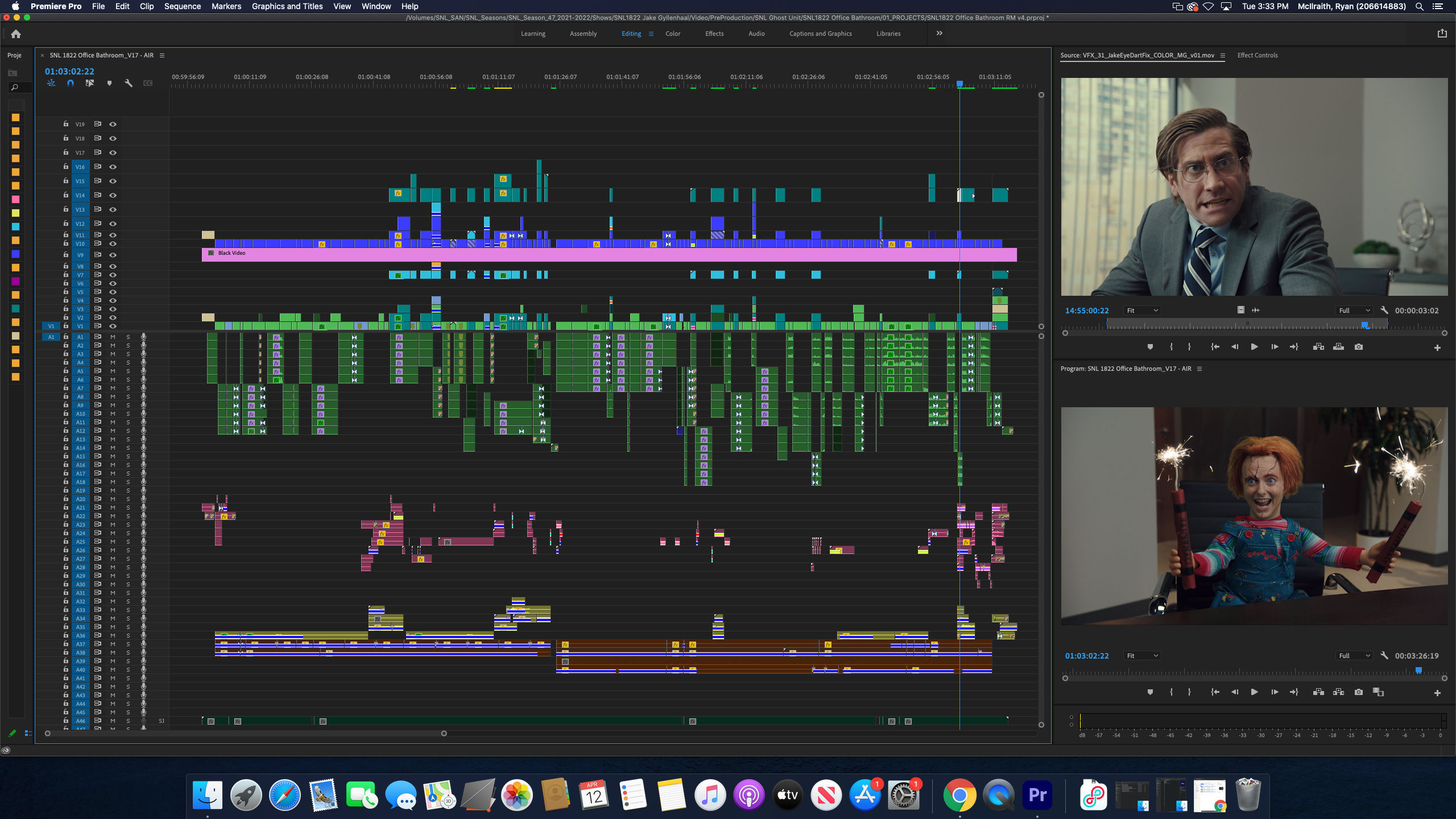
At SNL, we work exclusively with adobe products, so the team is able to just open the premiere sequence and bring those shots directly into after effects. On such a fast paced schedule, premiere allows us the flexibility to be able to roughly comp in these shots and get the piece to a place where it can be viewed without any of the final visual effects. On this one, we didn’t really start dropping in “final” VFX shots until about 5:00pm. Which, those shots weren’t exactly final, but they were good enough to stick in the cut for dress rehearsal to sell to an audience. Our ‘safety cut’ (a cut we send downstairs to the control booth just so they have something to play when our time is up) was due downstairs at 8:21pm so it was a race to get all of the shots in. We were able to deliver down to dress rehearsal 10 minutes before our piece played.
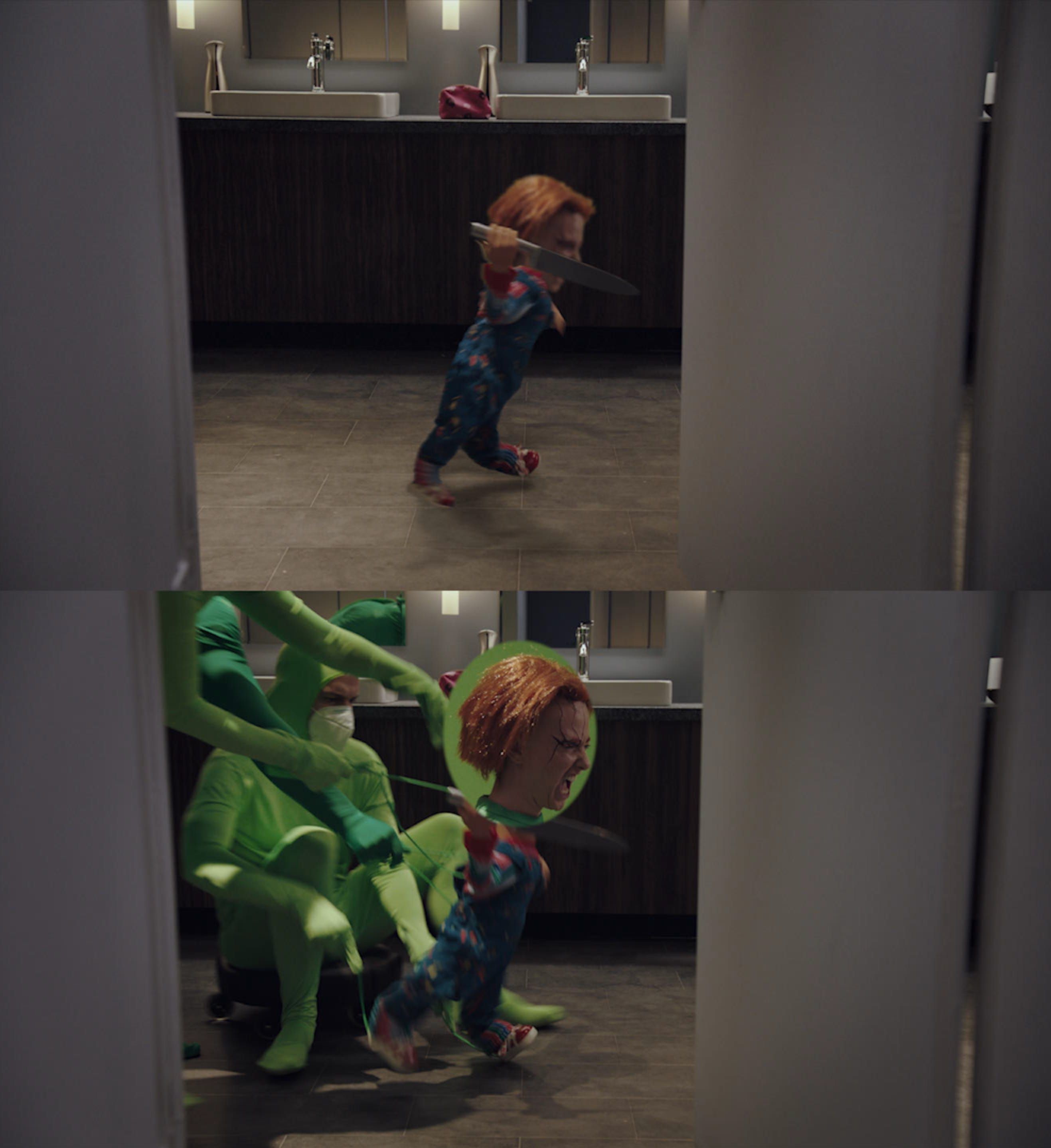
Between dress and air, most of the changes were cleaning up visual effects and laying in the final colored footage. We had a few minor trims to the edit. I believe we removed about 15 seconds. On a typical edit, we are able to conform the color prior to dress rehearsal but because we had such complex visual effects, we decided to not roll the dice. We had all of the visual effects done to the raw footage, then the VFX team relinked that to the colored footage between dress and air. When it comes to conforming, Paul Del Gesso is the fastest person I have ever worked with. Without him, I wouldn’t have gotten any of the VFX in the final cut. While I am making the changes, Paul is laying in the VFX and colored footage on his computer and then he exports me a sequence to lay on top of my edit. Together we go through and check everything to make sure nothing fell out of sync. This process was started at about 11:05pm. We were due to deliver our air safety cut at 11:48pm, so it was a bit of a race against the clock. Our final export was made at 11:57pm for air so we were a bit behind. The piece officially aired at 12:08pm and we all breathed a sigh of relief and cracked open a beer. I couldn’t believe how incredible the visual effects turned out but the team at SNL is the absolute best in the business.
What is your general approach for going from a mountain of footage to the final edit?
I think the hardest thing to do on a new edit is get started, to make the first edit in the timeline. I begin by looking at the all of the footage laid out in string outs. As I am screening it, if I see something I like, I bring it to the second layer of video. That way I can quickly look at a timeline and see my selects. If there is something I REALLY like, I immediately copy that and paste it into my main timeline, knowing that in one way or another, that piece of footage is making it into my first cut.
I am somebody that doesn’t like to start editing until I have all of the footage from a particular scene. I like to start at the beginning and work chronologically. At SNL, there is no such thing as a rough cut and we have to work incredibly fast. As soon as I see something I really like, or something that makes me laugh, I put it in the cut and move on. Once I have built an entire cut, I will immediately watch it back start to finish. Some of my gut instincts don’t always work in the bigger picture. For example, a line reading I thought was funny, sometimes feels out of place in the larger context of the piece. That’s when I will go in and start swapping takes.
I am always building sound beds before I edit any footage. This way all of my pieces already feel like they are in a particular environment and nobody has to imagine what it will sound and feel like. I’d say I spend an equal amount of time editing sound and editing footage. The biggest struggle I have editing these pieces is always how to end the sketch. We want to end on a punchline typically, this way we can go black on a loud laugh or big applause. I feel that even if you have a mediocre piece, a great ending can completely salvage it because that is what the audience will remember.
What advice would you give to someone wanting to do similar work?
Focus a lot on sound. So much of these jokes are sold in the sound design. I’d say go watch a bunch of pieces and pay close attention to what the editors did with the sound. Focus on the sound builds prior to a punchline and the cadence at which things are delivered. I’d also say you need to be incredibly meticulous about organization. With these pieces, we typically get about 12 hours to put together our first cut. After that, we are working in tandem with the director, writers and producers to field all of their notes. A lot of times, people will want to see all of the line readings of a particular line. You have to know the footage in and out and be able to immediately pull up those takes. The assistant editors at SNL are the best in the business and they are just as important to this process as the editors. They organize all of the footage in a way that makes it super easy for me to navigate. I was an assistant editor on these sketches for 3 years and it helped me get incredibly comfortable with the process. You should do a few years as an assistant editor so you can understand the workflow and how an edit room operates.
When do you know if a project is ready?
The short answer of this is that a project is never ready to go. You can tinker on an edit for years if they’d let you. I know in the past my brother and I are very guilty of this. We’d edit a project to death because we lacked the confidence to know when something is good enough. I think that’s an important skill to have, to be able to look at something and know that it is good enough and any further edits you make won’t really elevate the piece, but will really just be lateral moves. I’ve become much more confident in my instincts and that is really all that editing is. Editing is being able to trust your instincts and trust yourself. It’s important to know that sometimes you make a cut that you don’t love or agree with stylistically, but it serves the comedy of a piece or the punchline. Being able to let an edit like that go and move past it, is an important part of the job.
What kind of work would you like to do in the future?
In the future, i’d love to work on long form TV and Film. My brother Sean & I have worked together for years on our own projects and at SNL, where he is also an editor! We’ve loved our time at the show, but are definitely looking to get into longer form storytelling. It would be so damn nice to be on a project where the timeline is longer than 24 hours. Don’t get me wrong, it has certainly sharpened my skills, but i’m not sure how much longer my anxiety can handle this pace!